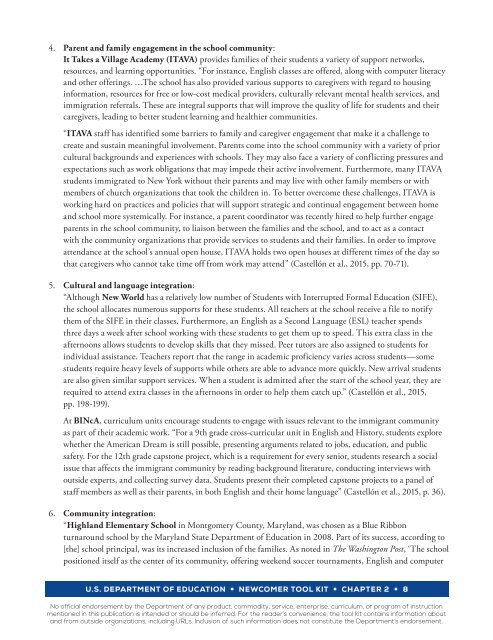NEWCOMER TOOL KIT
xYhe4
xYhe4
Create successful ePaper yourself
Turn your PDF publications into a flip-book with our unique Google optimized e-Paper software.
4. Parent and family engagement in the school community:<br />
It Takes a Village Academy (ITAVA) provides families of their students a variety of support networks,<br />
resources, and learning opportunities. “For instance, English classes are offered, along with computer literacy<br />
and other offerings. …The school has also provided various supports to caregivers with regard to housing<br />
information, resources for free or low-cost medical providers, culturally relevant mental health services, and<br />
immigration referrals. These are integral supports that will improve the quality of life for students and their<br />
caregivers, leading to better student learning and healthier communities.<br />
“ITAVA staff has identified some barriers to family and caregiver engagement that make it a challenge to<br />
create and sustain meaningful involvement. Parents come into the school community with a variety of prior<br />
cultural backgrounds and experiences with schools. They may also face a variety of conflicting pressures and<br />
expectations such as work obligations that may impede their active involvement. Furthermore, many ITAVA<br />
students immigrated to New York without their parents and may live with other family members or with<br />
members of church organizations that took the children in. To better overcome these challenges, ITAVA is<br />
working hard on practices and policies that will support strategic and continual engagement between home<br />
and school more systemically. For instance, a parent coordinator was recently hired to help further engage<br />
parents in the school community, to liaison between the families and the school, and to act as a contact<br />
with the community organizations that provide services to students and their families. In order to improve<br />
attendance at the school’s annual open house, ITAVA holds two open houses at different times of the day so<br />
that caregivers who cannot take time off from work may attend” (Castellón et al., 2015, pp. 70-71).<br />
5. Cultural and language integration:<br />
“Although New World has a relatively low number of Students with Interrupted Formal Education (SIFE),<br />
the school allocates numerous supports for these students. All teachers at the school receive a file to notify<br />
them of the SIFE in their classes. Furthermore, an English as a Second Language (ESL) teacher spends<br />
three days a week after school working with these students to get them up to speed. This extra class in the<br />
afternoons allows students to develop skills that they missed. Peer tutors are also assigned to students for<br />
individual assistance. Teachers report that the range in academic proficiency varies across students—some<br />
students require heavy levels of supports while others are able to advance more quickly. New arrival students<br />
are also given similar support services. When a student is admitted after the start of the school year, they are<br />
required to attend extra classes in the afternoons in order to help them catch up.” (Castellón et al., 2015,<br />
pp. 198-199).<br />
At BINcA, curriculum units encourage students to engage with issues relevant to the immigrant community<br />
as part of their academic work. “For a 9th grade cross-curricular unit in English and History, students explore<br />
whether the American Dream is still possible, presenting arguments related to jobs, education, and public<br />
safety. For the 12th grade capstone project, which is a requirement for every senior, students research a social<br />
issue that affects the immigrant community by reading background literature, conducting interviews with<br />
outside experts, and collecting survey data. Students present their completed capstone projects to a panel of<br />
staff members as well as their parents, in both English and their home language” (Castellón et al., 2015, p. 36).<br />
6. Community integration:<br />
“Highland Elementary School in Montgomery County, Maryland, was chosen as a Blue Ribbon<br />
turnaround school by the Maryland State Department of Education in 2008. Part of its success, according to<br />
[the] school principal, was its increased inclusion of the families. As noted in The Washington Post, ‘The school<br />
positioned itself as the center of its community, offering weekend soccer tournaments, English and computer<br />
U.S. DEPARTMENT OF EDUCATION • <strong>NEWCOMER</strong> <strong>TOOL</strong> <strong>KIT</strong> • CHAPTER 2 • 8<br />
No official endorsement by the Department of any product, commodity, service, enterprise, curriculum, or program of instruction<br />
mentioned in this publication is intended or should be inferred. For the reader’s convenience, the tool kit contains information about<br />
and from outside organizations, including URLs. Inclusion of such information does not constitute the Department’s endorsement.


